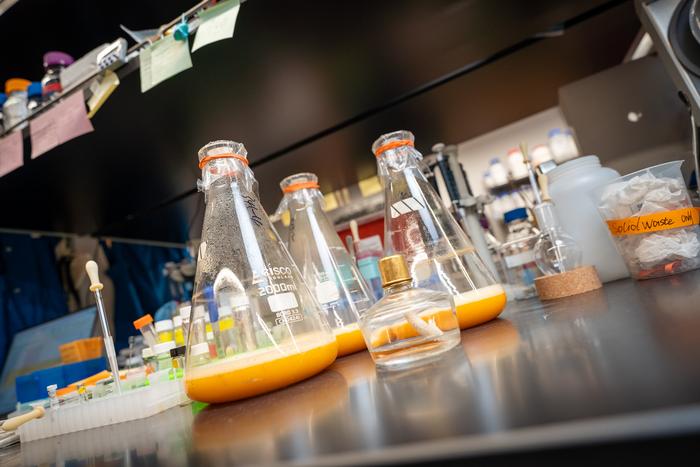A groundbreaking study led by researchers at the University of California San Diego has introduced an innovative method for producing strigolactones, a vital class of plant hormones, in previously unattainable quantities. This remarkable advancement stems from the use of engineered microbial cell factories, combining the capabilities of E. coli bacteria and yeast through co-culturing techniques. The importance of strigolactones lies in their significant role in controlling plant development, orchestrating symbiotic relationships with soil microorganisms, and mediating interactions with parasitic plants.
For years, the scientific community has recognized the potential of strigolactones in enhancing agricultural sustainability. However, the limited availability of these hormones from natural plant sources hindered comprehensive research efforts. Traditional extraction methods, which required enormous volumes of plant xylem sap—up to 1,000 liters—posed an ecological threat by necessitating the destruction of numerous trees. The novel approach developed by the UC San Diego team not only circumvents these limitations but also empowers researchers with sufficient quantities to explore the molecular intricacies of strigolactones in detail.
The research was published in the prestigious journal Science and is poised to shift paradigms in how scientists understand plant signaling and hormone production. Previous methods have yielded only small amounts of strigolactones, resulting in primarily speculative findings regarding their chemistry and ecological functions. Thus, the new method’s ability to produce over 125 times higher yields than previously achievable marks a significant milestone in the field.
In addition to improving extraction efficiencies, the study sheds light on the evolutionary aspects of strigolactone biosynthesis across different plant species. By leveraging genomic techniques, the researchers were able to investigate specific genes associated with strigolactone production. They focused particularly on gene families related to cytochrome P450 enzymes, which play essential roles in the biosynthetic pathways of these hormones. The identification and expression of sister genes, CYP722A and CYP722B, revealed their potential for yielding various biologically relevant strigolactones.
One particularly noteworthy compound that emerged from this research is 16-hydroxy-carlactonic acid (16-OH-CLA). Despite having been reported in previous studies, its structural details and biological significance remained elusive. The newfound capacity to produce substantial quantities of 16-OH-CLA enabled the team to elucidate its precise structure for the very first time. This revelation offers a new perspective on the roles strigolactones may play in plant signaling and stress responses.
The findings regarding 16-OH-CLA also raised intriguing questions about its spatial distribution within plants. Unlike other strigolactones, which are typically found in roots, this compound was detected primarily in shoots. This distinction hints at distinct physiological functions and raises the possibility of previously unrecognized signaling pathways at play. Additionally, the monitoring of its presence informs researchers about the compound’s role in plant life cycles, as it is primarily produced during specific growth stages and environmental conditions.
The versatility of this microbial cell factory method sets the stage for future explorations into the complex chemical landscape of plant hormones. As the researchers continue their investigations, they aim to unravel the mysteries surrounding not only strigolactones but also other related compounds that may drive plant adaptation and survival in fluctuating environments.
Furthermore, the implications of these findings extend beyond botanical science; they touch on the spheres of ecological research and sustainable agriculture. With a deeper understanding of how plants interact with their environment through hormones like strigolactones, agronomists can devise innovative strategies for crop management and yield enhancement. Such applications are crucial as society faces the dual challenges of food security and environmental sustainability.
The collaborative nature of this research—spanning institutions from UC San Diego to UC Riverside and Utsunomiya University in Japan—exemplifies the international urgency of advancements in plant science. Global agricultural practices are increasingly reliant on innovations that foster resilience in crops against environmental stressors while minimizing ecological footprints.
In conclusion, the pioneering study on microbial cell factories and strigolactone production marks a new era in plant research, offering unprecedented insights into plant hormones and their roles in growth and survival strategies. In a world grappling with ecological challenges, the implications of this research reach far beyond academia and hold the potential to transform agricultural practices for the betterment of society and the environment. The intersection of synthetic biology, genomic research, and plant physiology has produced groundbreaking techniques that promise to unveil the secrets of plant signaling, paving the way for innovations that could significantly impact global sustainability efforts.
These advancements raise critical questions about how we will approach our understanding of complex biological systems and the inherent interplay between plants and their surroundings. As researchers continue to explore the potential of engineered microbial systems in plant research, the scientific community eagerly anticipates further revelations that could revolutionize how we interact with the natural world.
Subject of Research: Strigolactone Biosynthesis
Article Title: Evolution of interorganismal strigolactone biosynthesis in seed plants
News Publication Date: 17-Jan-2025
Web References: DOI Link
References: None available
Image Credits: David Baillot/UC San Diego Jacobs School of Engineering
Keywords
Strigolactones, Microbial Cell Factories, Plant Hormones, Synthetic Biology, Metabolic Engineering, Sustainable Agriculture, Plant Physiology, Hormonal Signaling, Environmental Adaptation





